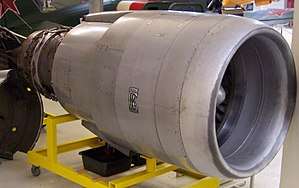Rolls-Royce/SNECMA M45H
| M45H | |
|---|---|
 | |
| M45H engine on display | |
| Type | Turbofan |
| National origin | United Kingdom / France |
| Manufacturer | Rolls-Royce/SNECMA |
| First run | 1970 |
| Major applications | VFW-Fokker 614 |
The Rolls-Royce/SNECMA M45H was a medium bypass ratio turbofan produced specifically for the twin-engined VFW-Fokker 614 aircraft in the early 1970s.
The design was started as a collaborative effort between Bristol Siddeley and SNECMA.[1]
Design and development

The VFW 614 was designed to operate over short sectors with up to a dozen flights a day. The engines were optimized for 30 minute sectors at a cruise altitude of 21,000 feet at Mach 0.65. Only a few minutes would be spent at the cruise rating and most of the flight would be at the higher climb rating or at a descent setting. The engine had a low turbine entry temperature and comparatively low rotational speed.[2]
The engine was designed to be uprated without drastic redesign. Three options were water injection (+10% thrust), improved HP turbine (+10% thrust), addition of a zero-stage to the LP compressor (+25% thrust).[2]
The engine was developed at the time of the Rolls-Royce bankruptcy which resulted in delays in developing the engine.[3]
Variants

- M45F
- Civil low bypass turbofan 7,915 lbf (35.21 kN) for take-off.[4]
- M45G
- Military low bypass turbofan 13,200 lbf (58.72 kN) for take-off, wet.[4]
- M45H
- Civil high bypass turbofan 7,880 lbf (35.05 kN) for take-off, wet.[4]
- RB.410
- Rolls-Royce designation for the M45SD-02 geared turbofan
- M45SD-02
- a derivative of the M45H-01 turbofan, designed to demonstrate ultra-quiet engine technologies, needed for STOL aircraft operating from city centre airports. A geared, variable pitch fan, replaced the first stage of the low pressure (LP) compressor. A modest fan pressure ratio, consistent with the high bypass ratio, meant a low fan tip speed could be employed. A low hot jet velocity was another major design feature. In reverse thrust, intake air entered the bypass duct, via a gap in the cold nozzle outer wall, and went through the fan, to be expelled through the intake. A small proportion of the bypass duct air entered the IP compressor, via a special diverter valve, to sustain the gas generator. Reverse thrust was obtained by the fan going through fine (rather than feather) pitch. Engine testing took place in the mid 1970s. The Chief Engineer of this project was David McMurtry, co-founder and Chairman of Renishaw PLC. After the prototype engine was stored, it was given to Sir David for safe keeping at the New Mills site.
Engines on display
A Rolls-Royce/SNECMA M45H engine is on display as part of the aero engine collection at the Royal Air Force Museum Cosford.
Specifications (M45H Mk.501)
Data from Jane's All the World's Aircraft 1971-72.[5]
General characteristics
- Type: Turbofan
- Length: 2,600 mm (102.4in)
- Diameter: 909 mm (35.8 in)
- Dry weight: 673 kg (1,483 lb)
Components
- Compressor: 5-stage intermediate pressure and 7-stage high-pressure axial compressor with a single-stage fan
- Bypass ratio: 2.85:1 [6]
- Combustors: Annular
- Turbine: 3-stage low pressure and single-stage high pressure turbines
Performance
- Maximum thrust: 7,300 lbf (32.4 kN[7])
- Overall pressure ratio: 16.5:1
- Thrust-to-weight ratio: 4.9:1
Specifications (M45SD-02)
Data from Flight International 1973 [8]
General characteristics
- Type: turbofan
- Length:
- Diameter:
- Dry weight:
Components
- Compressor: 5-stage intermediate pressure and 7-stage high-pressure axial compressor with a geared, single-stage, variable-pitch, fan
- Combustors: Annular
- Turbine: 4-stage low pressure and single-stage high pressure turbines
Performance
- Maximum thrust: 10,000 lbf (44.48 kN)
- Bypass ratio: 8.73:1
- Fuel consumption: 3 200 lb/hr (1,451 kg/hr)
- Specific fuel consumption: 0.32 lb/hr/lbf (9.064 g/s/KN)
- Power-to-weight ratio:
See also
Comparable engines
Related lists
References
- Notes
- ↑ Flight 6 January 1966
- 1 2 https://www.flightglobal.com/pdfarchive/view/1974/1974%20-%200622.html
- ↑ Swanborough 1971, p.371.
- 1 2 3 Wilkinson, Paul H. (1966). Aircraft engines of the World 1966/77 (21st ed.). London: Sir Isaac Pitman & Sons Ltd. pp. 165–167.
- ↑ J W R Taylor 1971,p.650.
- ↑ http://www.flightglobal.com/FlightPDFArchive/1971/1971%20-%202336.PDF
- ↑ "Archived copy" (PDF). Archived from the original (PDF) on 6 June 2011. Retrieved 21 October 2007.
- ↑ D. G. M. Davis (19 April 1973), "Progress in Britain" (pdf), Flight International: 615
- Bibliography
- Swanborough, Gordon. Air Enthusiast, Volume One. London: Pilot Press, 1971. ISBN 0-385-08171-5.
External links
| Wikimedia Commons has media related to Rolls-Royce/SNECMA M45H. |
- Stol Fans from Dowty a 1971 Flight article